Page 1199 of 2890
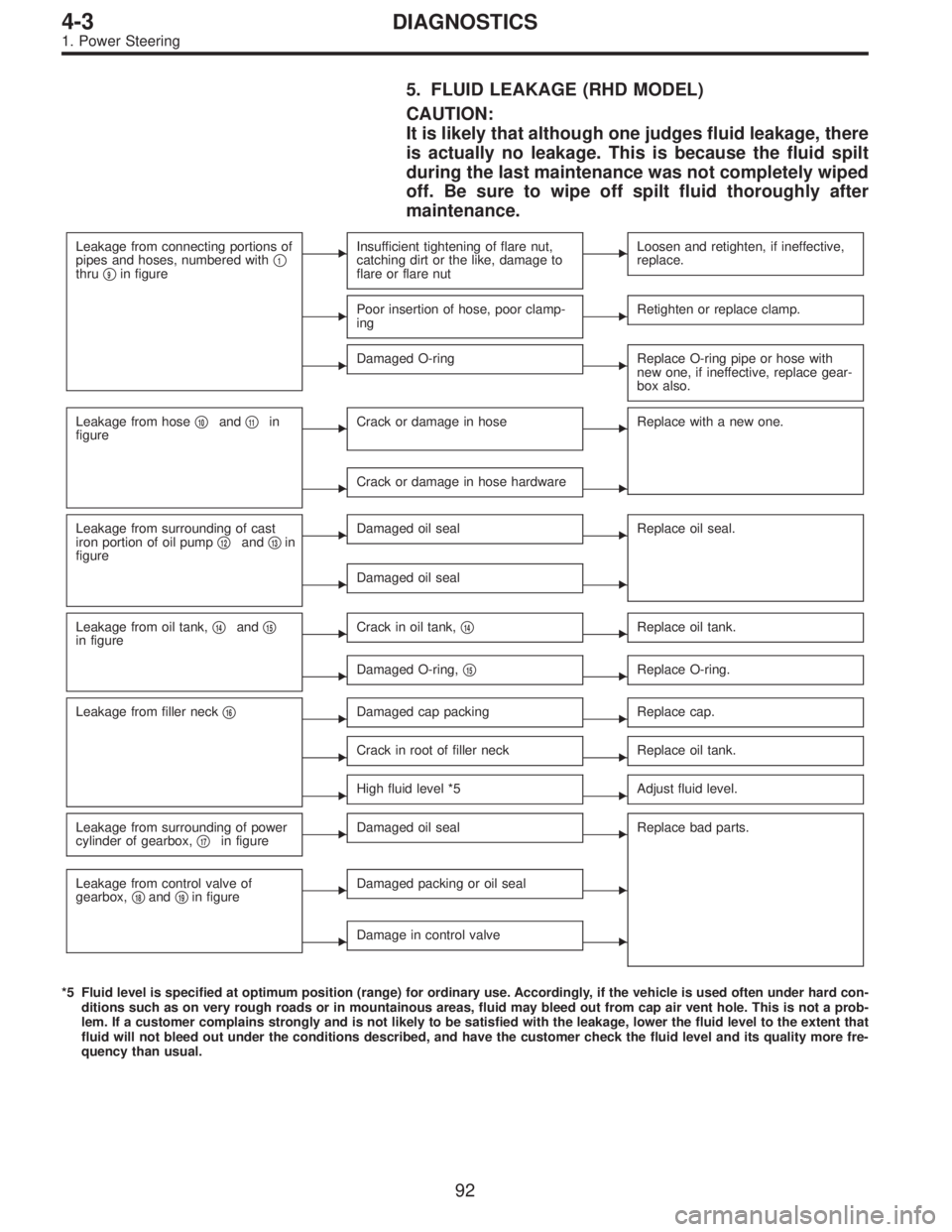
5. FLUID LEAKAGE (RHD MODEL)
CAUTION:
It is likely that although one judges fluid leakage, there
is actually no leakage. This is because the fluid spilt
during the last maintenance was not completely wiped
off. Be sure to wipe off spilt fluid thoroughly after
maintenance.
Leakage from connecting portions of
pipes and hoses, numbered with�1thru�9in figure
�Insufficient tightening of flare nut,
catching dirt or the like, damage to
flare or flare nut�Loosen and retighten, if ineffective,
replace.
�Poor insertion of hose, poor clamp-
ing�Retighten or replace clamp.
�Damaged O-ring�Replace O-ring pipe or hose with
new one, if ineffective, replace gear-
box also.
Leakage from hose�10and�11in
figure�Crack or damage in hose�Replace with a new one.
�Crack or damage in hose hardware�
Leakage from surrounding of cast
iron portion of oil pump�12and�13in
figure�Damaged oil seal�Replace oil seal.
�Damaged oil seal�
Leakage from oil tank,�14and�15in figure�Crack in oil tank,�14�Replace oil tank.
�Damaged O-ring,�15�Replace O-ring.
Leakage from filler neck�16�Damaged cap packing�Replace cap.
�Crack in root of filler neck�Replace oil tank.
�High fluid level *5�Adjust fluid level.
Leakage from surrounding of power
cylinder of gearbox,�17in figure�Damaged oil seal�Replace bad parts.
Leakage from control valve of
gearbox,�18and�19in figure�Damaged packing or oil seal�
�Damage in control valve�
*5 Fluid level is specified at optimum position (range) for ordinary use. Accordingly, if the vehicle is used often under hard con-
ditions such as on very rough roads or in mountainous areas, fluid may bleed out from cap air vent hole. This is not a prob-
lem. If a customer complains strongly and is not likely to be satisfied with the leakage, lower the fluid level to the extent that
fluid will not bleed out under the conditions described, and have the customer check the fluid level and its quality more fre-
quency than usual.
92
4-3DIAGNOSTICS
1. Power Steering
Page 1200 of 2890
B4M0675A
93
4-3DIAGNOSTICS
1. Power Steering
Page 1201 of 2890
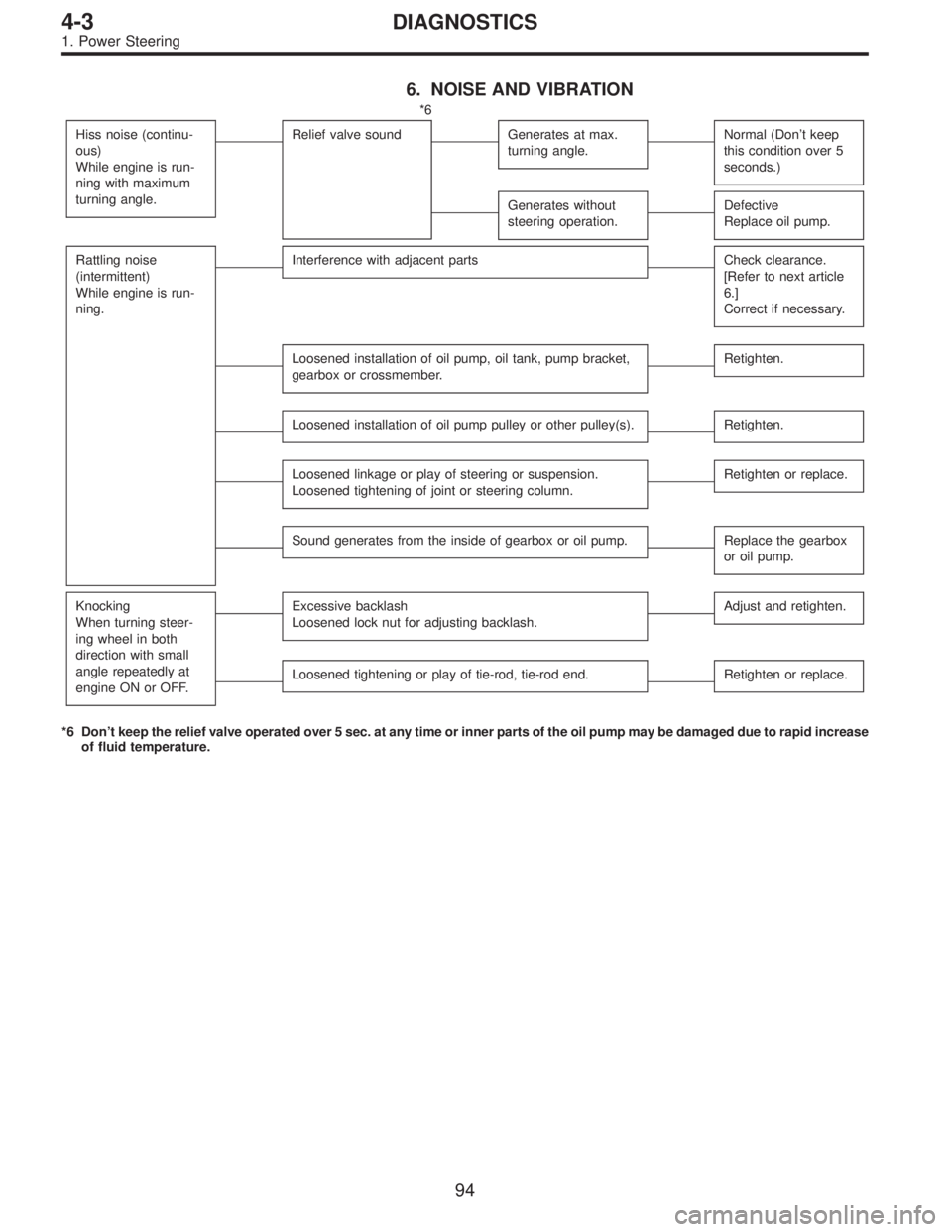
6. NOISE AND VIBRATION
*6
Hiss noise (continu-
ous)
While engine is run-
ning with maximum
turning angle.
Relief valve soundGenerates at max.
turning angle.Normal (Don’t keep
this condition over 5
seconds.)
Generates without
steering operation.Defective
Replace oil pump.
Rattling noise
(intermittent)
While engine is run-
ning.Interference with adjacent partsCheck clearance.
[Refer to next article
6.]
Correct if necessary.
Loosened installation of oil pump, oil tank, pump bracket,
gearbox or crossmember.Retighten.
Loosened installation of oil pump pulley or other pulley(s).Retighten.
Loosened linkage or play of steering or suspension.
Loosened tightening of joint or steering column.Retighten or replace.
Sound generates from the inside of gearbox or oil pump.Replace the gearbox
or oil pump.
Knocking
When turning steer-
ing wheel in both
direction with small
angle repeatedly at
engine ON or OFF.Excessive backlash
Loosened lock nut for adjusting backlash.Adjust and retighten.
Loosened tightening or play of tie-rod, tie-rod end.Retighten or replace.
*6 Don’t keep the relief valve operated over 5 sec. at any time or inner parts of the oil pump may be damaged due to rapid increase
of fluid temperature.
94
4-3DIAGNOSTICS
1. Power Steering
Page 1202 of 2890
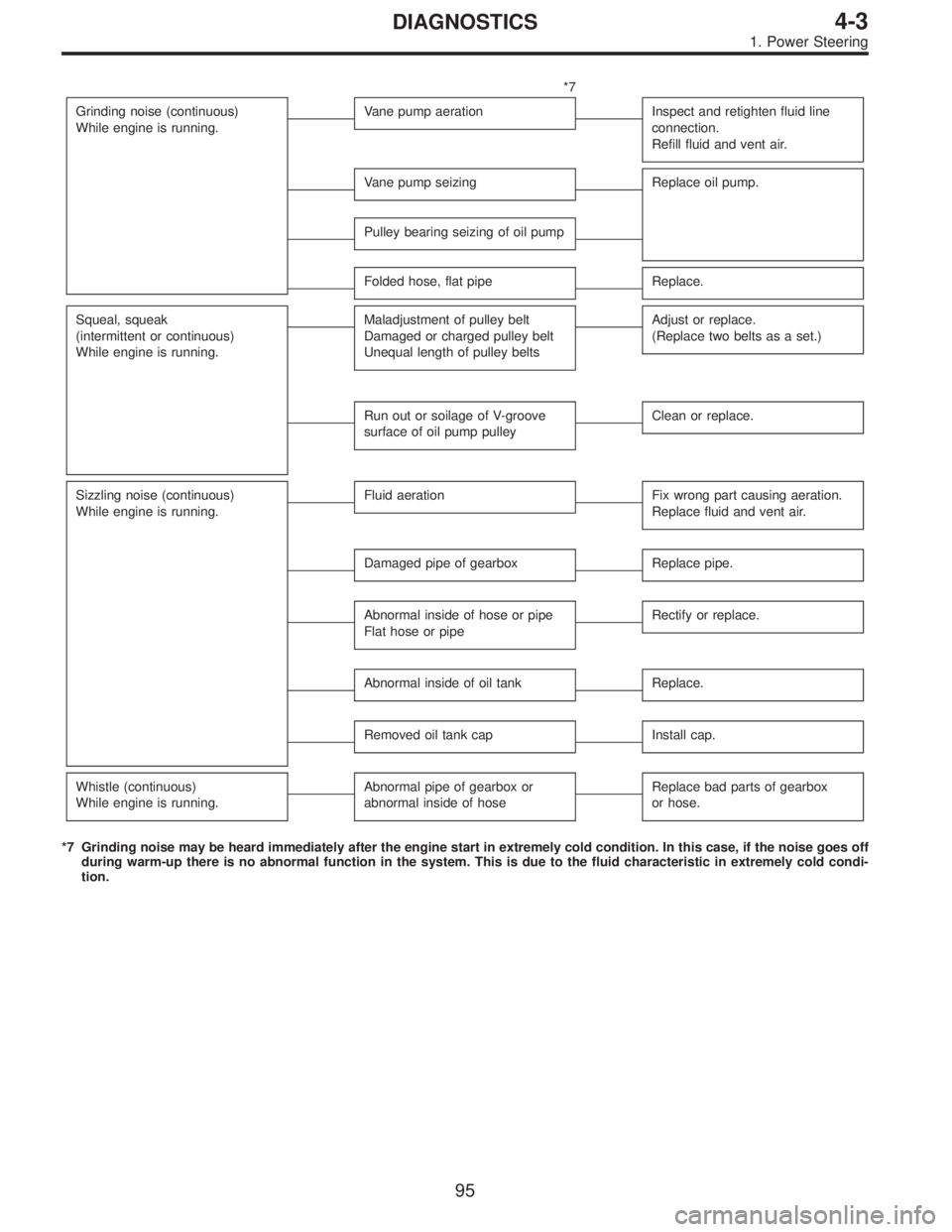
*7
Grinding noise (continuous)
While engine is running.
Vane pump aerationInspect and retighten fluid line
connection.
Refill fluid and vent air.
Vane pump seizingReplace oil pump.
Pulley bearing seizing of oil pump
Folded hose, flat pipeReplace.
Squeal, squeak
(intermittent or continuous)
While engine is running.Maladjustment of pulley belt
Damaged or charged pulley belt
Unequal length of pulley beltsAdjust or replace.
(Replace two belts as a set.)
Run out or soilage of V-groove
surface of oil pump pulleyClean or replace.
Sizzling noise (continuous)
While engine is running.Fluid aerationFix wrong part causing aeration.
Replace fluid and vent air.
Damaged pipe of gearboxReplace pipe.
Abnormal inside of hose or pipe
Flat hose or pipeRectify or replace.
Abnormal inside of oil tankReplace.
Removed oil tank capInstall cap.
Whistle (continuous)
While engine is running.Abnormal pipe of gearbox or
abnormal inside of hoseReplace bad parts of gearbox
or hose.
*7 Grinding noise may be heard immediately after the engine start in extremely cold condition. In this case, if the noise goes off
during warm-up there is no abnormal function in the system. This is due to the fluid characteristic in extremely cold condi-
tion.
95
4-3DIAGNOSTICS
1. Power Steering
Page 1203 of 2890
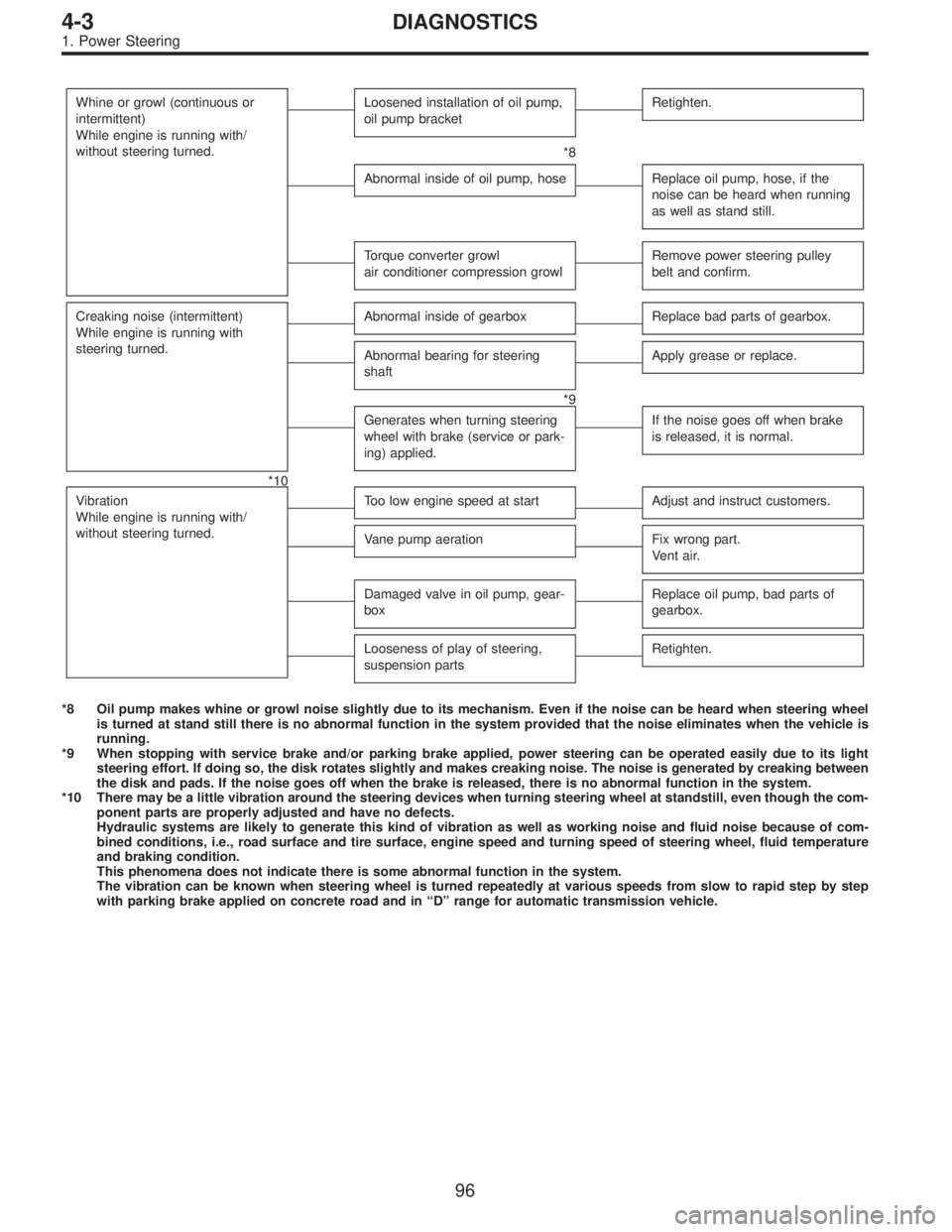
Whine or growl (continuous or
intermittent)
While engine is running with/
without steering turned.Loosened installation of oil pump,
oil pump bracketRetighten.
*8
Abnormal inside of oil pump, hoseReplace oil pump, hose, if the
noise can be heard when running
as well as stand still.
Torque converter growl
air conditioner compression growlRemove power steering pulley
belt and confirm.
Creaking noise (intermittent)
While engine is running with
steering turned.Abnormal inside of gearboxReplace bad parts of gearbox.
Abnormal bearing for steering
shaftApply grease or replace.
*9
Generates when turning steering
wheel with brake (service or park-
ing) applied.If the noise goes off when brake
is released, it is normal.
*10
Vibration
While engine is running with/
without steering turned.
Too low engine speed at startAdjust and instruct customers.
Vane pump aerationFix wrong part.
Vent air.
Damaged valve in oil pump, gear-
boxReplace oil pump, bad parts of
gearbox.
Looseness of play of steering,
suspension partsRetighten.
*8 Oil pump makes whine or growl noise slightly due to its mechanism. Even if the noise can be heard when steering wheel
is turned at stand still there is no abnormal function in the system provided that the noise eliminates when the vehicle is
running.
*9 When stopping with service brake and/or parking brake applied, power steering can be operated easily due to its light
steering effort. If doing so, the disk rotates slightly and makes creaking noise. The noise is generated by creaking between
the disk and pads. If the noise goes off when the brake is released, there is no abnormal function in the system.
*10 There may be a little vibration around the steering devices when turning steering wheel at standstill, even though the com-
ponent parts are properly adjusted and have no defects.
Hydraulic systems are likely to generate this kind of vibration as well as working noise and fluid noise because of com-
bined conditions, i.e., road surface and tire surface, engine speed and turning speed of steering wheel, fluid temperature
and braking condition.
This phenomena does not indicate there is some abnormal function in the system.
The vibration can be known when steering wheel is turned repeatedly at various speeds from slow to rapid step by step
with parking brake applied on concrete road and in“D”range for automatic transmission vehicle.
96
4-3DIAGNOSTICS
1. Power Steering
Page 1204 of 2890
7. CLEARANCE TABLE (LHD MODEL)
CAUTION:
This table lists various clearances that must be cor-
rectly adjusted to ensure normal vehicle driving with-
out interfering noise, or any other faults.
LocationMinimum
allowance
mm (in)LocationMinimum
allowance
mm (in)
�
1Crossmember—Pipe5 (0.20)�6Exhaust pipe—Pipe15 (0.59)
�
2DOJ—Shaft or joint14 (0.55)�7Exhaust pipe—Gearbox bolt15 (0.59)
�
3DOJ—Valve housing11 (0.43)�8Side frame—Hose A and B15 (0.59)
�
4Pipe—Pipe
2 (0.08)�
9Cruise control pump—Hose A and B15 (0.59)
Pipe—Crossmember�
10Pipe portion of hose A—Pipe portion of hose B1.5
(0.059)
�
5Stabilizer—Pipe5 (0.20)�11AT cooling hose—Joint20 (0.79)
B4M0565A
97
4-3DIAGNOSTICS
1. Power Steering
Page 1205 of 2890
8. CLEARANCE TABLE (RHD MODEL)
CAUTION:
This table lists various clearances that must be cor-
rectly adjusted to ensure normal vehicle driving with-
out interfering noise, or any other faults.
LocationMinimum
allowance
mm (in)LocationMinimum
allowance
mm (in)
�
1Crossmember—Pipe5 (0.20)�5Stabilizer—Pipe5 (0.20)
�
2DOJ—Shaft or joint14 (0.55)�6Exhaust pipe—Pipe15 (0.59)
�
3DOJ—Valve housing11 (0.43)�7Exhaust pipe—Gearbox boot15 (0.59)
�
4Pipe—Pipe
2 (0.08)�
8Side frame—Hose A and B15 (0.59)
Pipe—Crossmember�9Pipe portion of hose A—Pipe portion of hose B1.5
(0.059)
B4M0676A
98
4-3DIAGNOSTICS
1. Power Steering
Page 1206 of 2890
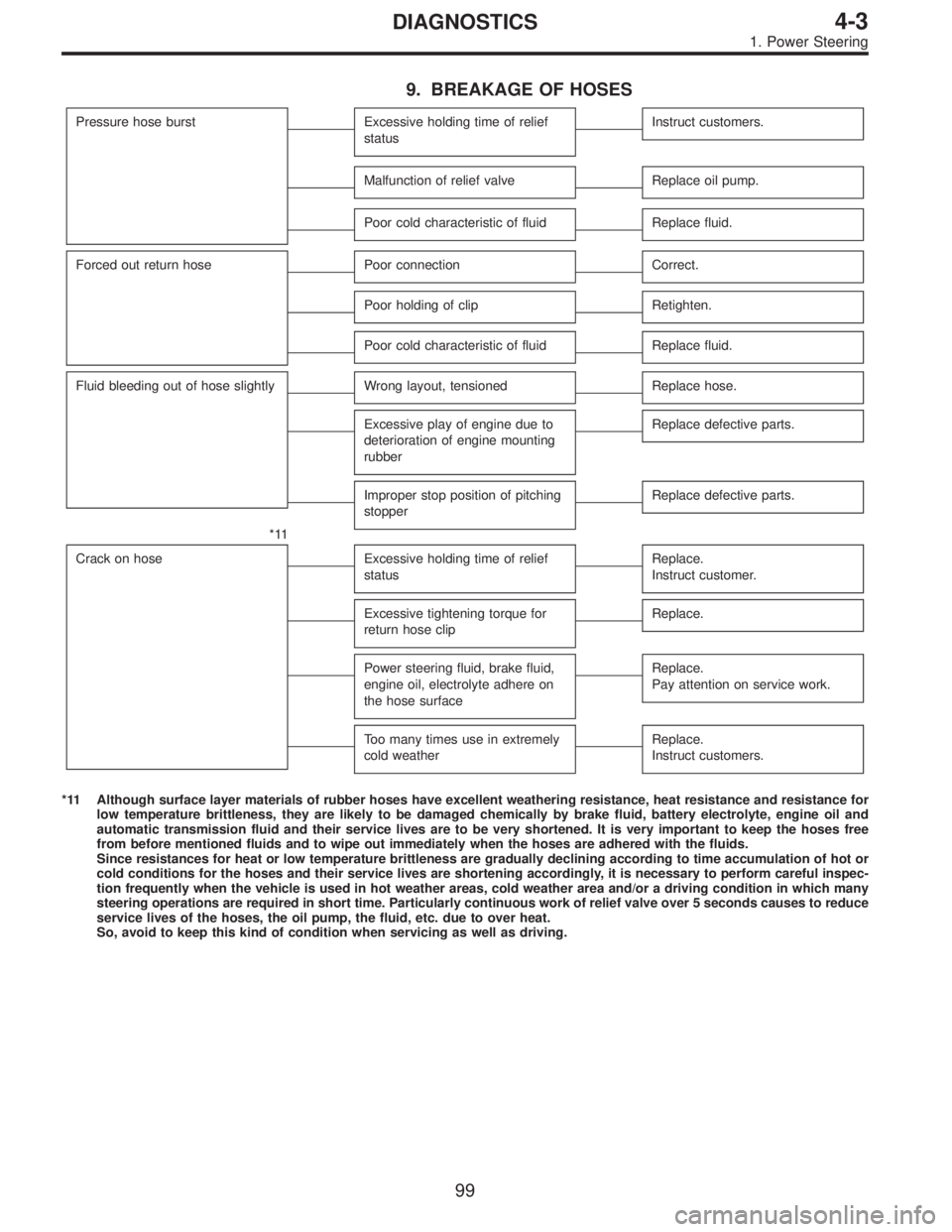
9. BREAKAGE OF HOSES
Pressure hose burstExcessive holding time of relief
statusInstruct customers.
Malfunction of relief valveReplace oil pump.
Poor cold characteristic of fluidReplace fluid.
Forced out return hosePoor connectionCorrect.
Poor holding of clipRetighten.
Poor cold characteristic of fluidReplace fluid.
Fluid bleeding out of hose slightlyWrong layout, tensionedReplace hose.
Excessive play of engine due to
deterioration of engine mounting
rubberReplace defective parts.
Improper stop position of pitching
stopperReplace defective parts.
*11
Crack on hose
Excessive holding time of relief
statusReplace.
Instruct customer.
Excessive tightening torque for
return hose clipReplace.
Power steering fluid, brake fluid,
engine oil, electrolyte adhere on
the hose surfaceReplace.
Pay attention on service work.
Too many times use in extremely
cold weatherReplace.
Instruct customers.
*11 Although surface layer materials of rubber hoses have excellent weathering resistance, heat resistance and resistance for
low temperature brittleness, they are likely to be damaged chemically by brake fluid, battery electrolyte, engine oil and
automatic transmission fluid and their service lives are to be very shortened. It is very important to keep the hoses free
from before mentioned fluids and to wipe out immediately when the hoses are adhered with the fluids.
Since resistances for heat or low temperature brittleness are gradually declining according to time accumulation of hot or
cold conditions for the hoses and their service lives are shortening accordingly, it is necessary to perform careful inspec-
tion frequently when the vehicle is used in hot weather areas, cold weather area and/or a driving condition in which many
steering operations are required in short time. Particularly continuous work of relief valve over 5 seconds causes to reduce
service lives of the hoses, the oil pump, the fluid, etc. due to over heat.
So, avoid to keep this kind of condition when servicing as well as driving.
99
4-3DIAGNOSTICS
1. Power Steering